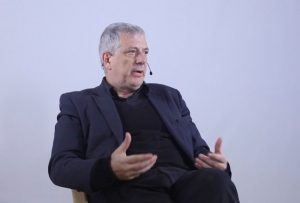Controlling and Reanimating the Brain
Neuroscientist Emery Brown on the anesthetic state, the arousal network, and medical coma
Brain imaging is the measurement of brain responses to changes in stimuli, changes in mood. If anything you think of that the brain can do, then you can challenge the brain experimentally and then measure how the brain responds to those challenges. The imaging bit comes from the fact that the brain has a particular architecture, a particular anatomy. So certain parts of the brain are specialized for performing certain functions. For example, there’s a particular part of my brain, largely about here, that’s specifically engaged by visual motion – watching moving things and analyzing and processing that information to try and infer or work out the causes of those visual sensations. To know that, you have to be able to measure the whole brain and establish which parts of those brains respond selectively to the particular attribute or the particular function that you’re interested in. That requires a measurement of brain responses, and that’s essentially what we do here, in the Wellcome Trust Center for Neuroimaging at the University College London.
There are a number of different ways that one can measure brain responses. They can roughly fall into two classes. The first – our measurements that depend upon the brain’s energy supply and blood supply. So, clearly if you’re using your brain to process visual information, that requires energy, requires work. In fact, the brain accounts for a considerable proportion of the body’s energy budget. That work is localized. There’s an increase, or blushing, if you like, of different parts of the brain in response to processing that sort of information, for example, visual motion. That can be measured, if you can assess the local blood flow or the consequences of that non-invasively, by which I mean measuring from outside the skull. What a lot of the work that we do here, at the Wellcome Trust center, is to measure the blood flow or the hemodynamic responses in terms of subtle changes in magnetic fields, or the signals produced by the differences in the magnetic behavior of blood before and after it has given up its oxygen to the nervous tissue so that they can do the processing, do the neuronal firing.
That notion and that basic paradigm can be generalized to any sensory, motor, cognitive, emotional processing or situation that you can imagine. So, we can look at the correlates, the hemodynamic correlates, the blood flow correlates of working memory, of processing various emotional stimuli, like fearful faces, we can look at the correlates of being in different brain states, for example, being depressed or not being depressed, or being elated and not being elated, anxious. In this way, we can build up literally a map, and very often people have described much of early brain imaging as a cartography, a map-building exercise that allows you to find various functions to functionally specialized parts of the brain thereby creating a literary an atlas or a map of which parts of the brain do what, and ultimately how different parts of the brain talk to each other, you’re building a picture of functional anatomy, an anatomy of processing information, I repeat, from the sensory processing, right through to the cognitive operations, such as attention and memory, to get a holistic and global picture of how the brain works.
Now, I said at the beginning the brain imaging technologies come in two flavors. I’ve been talking about techniques that rest upon functional magnetic resonance imaging or positron emission tomography. These are literally devices that provide or offer you an image, a snapshot of brain activity at one point in time, usually over several seconds. So, what we are looking at are not the actual fluctuations in electromagnetic activity that their cells engage in or the fast synaptic presences that mediate neural processing, but the energy supply that is necessary to sustain that level of information processing or message passing. The fluctuations in that energy supply are in the order of four to five seconds, so we’re looking at fluctuations over quite extended periods of time. We can do that with exquisite spatial precision. The little elements that constitute the entire brain imaging can be as small as a few millimeters, so it can measure almost down to the resolutions of a few millimeters the specific responses to those experimental paradigms. But clearly there’s very little temporal acuity, there’s a little temporal precision in these sorts of measurements. Because the way that your brain works is on a timescale measured in milliseconds. You notice things, if you think and you move on a timescale where things happen several times a second, if not several times every few hundred milliseconds.
Now we turn to the other sort of brain imaging, which is the measurement of the actual electrical and magnetic signals generated by the nervous activity. And this fluctuates very quickly. So, if I were to present you a single dot visually and I left it on the screen for say 50 milliseconds, that would create a barrage of nervous impulses that would propagate from your eyes through various subcortical structures to the back of the brain and then bounce forward and go everywhere. Each part of the brain taking from it, or some people would say, trying to predict the causes of that sensory information that I provided to you. And in doing that what you see are fast fluctuations in the electromagnetic field that can be picked up by sensors that are placed either on the scalp or – in the case of magnetic sensors – slightly distant from the scalp to get a picture from very different points of view of these fast fluctuations ripples in electromagnetic activity that are different at every point in the brain. So, this would be electromagnetic brain imaging. It would be the sort of imaging that you will associate with EEG or Magnetoencephalography or electroencephalography. But measures respectively the magnetic and the electrical consequences of this nervous activity, this neuronal firing induced by experimental design.
In conclusion, brain imaging is in the game of acquiring measurements that inform our understanding of how the brain passes messages of a neuronal sort from one part of the brain to the other in order to make sense of the world. We’ve got two ways of doing that. We can either look at the spatial deployment on the energetics that is induced by your own processing, using technologies like that magnetic resonance imaging or positron emission tomography. Or we can get into the detailed temporal structure by looking at electromagnetic responses using sensors that are external to the brain.

Neuroscientist Emery Brown on the anesthetic state, the arousal network, and medical coma

Economist Sacha Bourgeois-Gironde on human's economic behavior, animal's behavior research, and human adaptabi...

Historian Alessandro Scafi on the four rivers of paradise, Calvin's mapping of Eden, and the first attempts to...